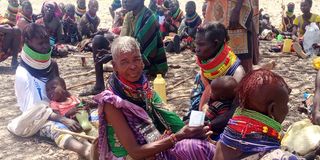Red Cross in Sh65m support programme for starving Turkana families

Women from Atapar village in Turkana North Sub-County on September 21, 2022 at one of the water scooping holes that they rely on as a result of drought.
What you need to know:
- 510,000 people in Turkana County alone face starvation as a result of the worsening drought.
- The county global acute malnutrition rate now stands at 20.4 percent.
The Kenya Red Cross Society is rolling out a Sh65 million cash and voucher assistance programme in Turkana targeting 5,000 hunger-stricken households as part of drought interventions.
Secretary-general Dr Asha Mohammed on Wednesday confirmed that 510,000 people in Turkana County alone face starvation as a result of the worsening drought.
She said more people will be affected, with predictions that the October-December rainfall will be below average.
During assessment visits in far-flung villages in Turkana North and Turkana Central sub-counties, identified by the KRCS as the hardest-hit, Dr Mohammed said the drought is at the alarm stage.
She said hundreds of residents desperately need immediate relief food, medical services and water.
Dr Mohammed said the agency is also supporting health outreach because some areas are vast and health facilities are far from settlements.
The county global acute malnutrition rate now stands at 20.4 percent, which is beyond the World Health Organization acknowledged global acute malnutrition rate of 15 percent.
The KRCS boss observed that with many families having lost most or all their livestock, they are embracing alternative sources of livelihoods that are not viable environmentally.
"We are at the same time witnessing a lot of environmental degradation where communities cut down trees for charcoal and firewood business ventures,” Dr Mohammed said.
“Drought being attributed to climate change, it will remain a vicious cycle if residents are not supported to engage in environment-friendly ventures."
To save pastoralists from losing their livestock, the KRCS is partnering with the government through the Kenya Meat Commission (KMC) to buy animals from residents, slaughter them and distribute meat to families to cushion them from the devastating effects of drought.
She said greater resources should be mobilised and directed to the affected communities, saying her agency is committed to supporting efforts by the national and county governments to mitigate the disaster.
"We intend to go above and beyond food distribution, working with families in affected counties to understand the most vital sustainable measures to curb their suffering," Dr Mohammed said.
Worst drought
Interactions with residents of Atapar village in Turkana North who have experienced drought before showed that this is the worst drought ever, said Jorgen Haldorsen, the director of international programmes and preparedness at the Norwegian Red Cross.
“Basic necessities in remote villages are hard to get and prices have increased, worsening the situation. The interventions require collective responsibility by all partners," Mr Haldorsen said.
James Esurot, a herder in Nayenaeapu village, said he had lost 20 goats because of lack of pasture and water.
"I don’t have any other source of livelihood other than the livestock that are dying day and night. I need water and livestock feeds to rescue the remaining four, which can provide my family with milk and blood," Mr Esurot said.
Ms Margaret Eyanae, a resident at Atapar village, said families who have lost all their livestock are the weakest.
"Three people in the village can't move out of their houses without being helped by neighbours. We fear that they can die anytime if they are not provided with food and medical assistance," Ms Eyanae said.





